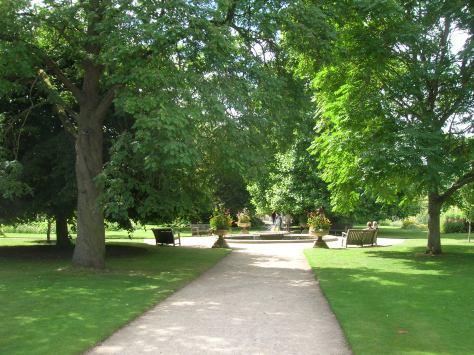Introduced last year, the online catalogue Medieval Manuscripts in Oxford Libraries provides descriptions of the 10,000-odd Western medieval manuscripts in the Bodleian Library, as well as those of a few Oxford colleges, and saves one entering the somewhat bewildering world of the Bodleian’s print catalogues.
Tag Archives: Bodleian
Oxford’s Libraries
Anyone who has spent five minutes in Oxford knows about the Bodleian Library, but the university actually brims over with dozens of libraries, each with its own charms (admittedly, some more than others). The following are the libraries I tend to use most in the course of my various research tangents. (The unfortunate lack of decent interior pictures of my own is due to library regulations against wandering around like a tourist snapping shots of the ceiling.)
The Final Stretch (Long Vac)
A summer that once looked invitingly long and leisurely has since sped mercilessly by, week after fleeting week. In less than nine days’ time, we are due at the Examination Schools, dissertations in hand.
My own dissertation is finished, in the sense that I have 15,000 words that run in more-or-less coherent a fashion from the first page to the last. What I no longer have, after a long series of 8- to 10-hour days in the libraries, madly typing and deleting and typing some more, is any true sense of whether those words manage to say anything in a reasonably intelligent fashion.
There are over 100 steps, not to mention a very long corridor, between the Lower Gladstone Link and the Upper Reading Room in the Bodleian (I did try to count the steps exactly, but I got mired in a group of tourists outside Duke Humphrey’s and lost track), and I have climbed them many, many times over the past two weeks in the seemingly never-ending quest for citation information, bumping in similarly harried classmates in various reading rooms along the way.
But the worst of it is now over and I badly need a break to recover some perspective, so once I dropped my draft off for my supervisor, I decided to enjoy the day in true Oxford style. As a sop to productivity, I started by fetching an essay I had been meaning to read by Alexander Murray (quickly becoming one of my new favourite historians) and took it up into one of Oxford’s most quintessential places—the little gallery of the Duke Humphrey’s Library—to read it in the glow of a little reading lamp, perched high above the room’s medieval splendour.
Then, as it was beautiful summer day—the sort that Oxford can do so very well, if only she puts her mind to it—it was obviously time for a picnic. I recruited a friend, poked around the Covered Market in search of comestibles (like bacon and brie quiche!), and set off for the Oxford Botanic Gardens, a charming place of riotous colour into which University members are admitted free of charge. We strolled around the grounds and greenhouses, watching the punts go by on the Cherwell, then laid out our blanket in the shade of a leafy tree and ate and drank and chatted the afternoon away.

Digital Bodleian
Online digitized facsimiles of some of the best of the Bodleian collections, including quite a few medieval manuscripts.
Tip: The Digital Bodleian manuscript viewer interface isn’t the most user friendly if you’re trying to look through the manuscript as a whole instead of just one image, but if you look in the right-hand panel under the metadata, there are icons to view the manuscript in Universal Viewer or Mirador, both of which are quite good.
Forays into Manuscripts (5th Week, HT)
This week I requested my first manuscripts from Special Collections – which doesn’t sound all that impressive until you take into account that this involves a Bodleian librarian cheerfully handing over 800-year-old books into my grubby carefully scrubbed hands.
Anatomy of a Reading List (2nd Week, HT)
One seminar a week certainly doesn’t sound like very much – until you see the week’s reading list. Last term, the reading for the seminar was one to three books a week. For “The Twelfth-Century Renaissance”, the reading list comes in the shape of a full A4 sheet of paper with about half-a-dozen books of primary texts, another half-dozen secondary books, and perhaps another dozen journal articles and essays, all supposedly discoverable somewhere in the vastness of the Oxford library system.
Essaying Essays (6th Week, MT)
It’s interesting that the etymology of the word essay goes back to the Latin word exigere, which means “to weigh, or put to the test”. While in Oxford the word does typically just refer to “a short piece of writing on a particular subject”, that older definition is actually feeling pretty accurate at the moment.
Settling In (-1 Week, Michaelmas Term)
With a week of Latin class under our belts, and yet still another week until inductions and welcome events start in 0th week, we are feeling somewhat betwixt-and-between as students at the moment.









